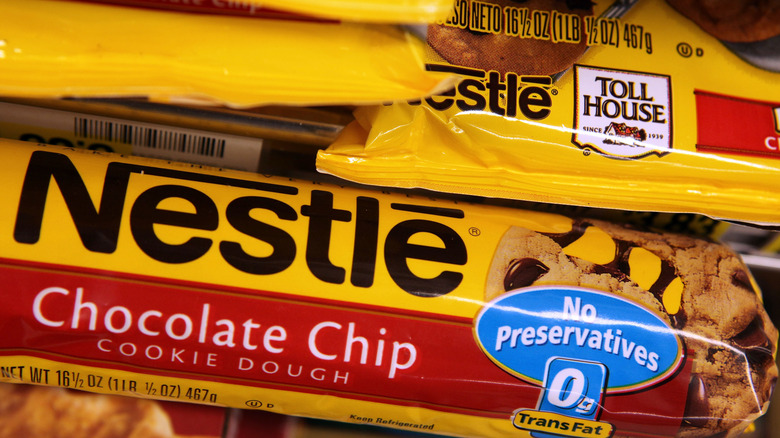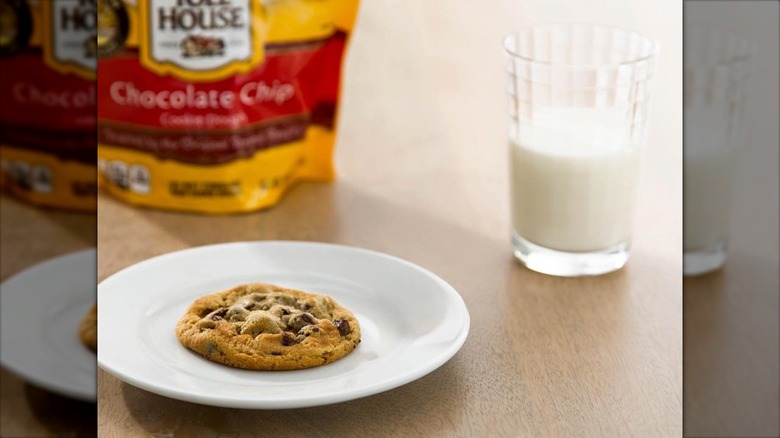Toll House Cookies Trace Their Roots Back To The Great Depression
Ruth Wakefield was a woman ahead of her time. In 1930, less than a year after the stock market crash that sent the country into financial pandemonium leading to what remains the longest economic downturn in U.S. history, Wakefield and her husband, Kenneth, decided to open a restaurant. The couple purchased a property in Whitman, Massachusetts, about 25 miles south of Boston, with the intention of opening an inn and restaurant. Undeterred by economic uncertainty, they went ahead with their plans and, against long odds, successfully owned and operated The Toll House Inn for 37 years.
Did you catch the name of the Wakefields' restaurant? It's not a coincidence. The Toll House Inn is the birthplace of the Toll House Cookie. Stories of the genesis of ubiquitous cookies vary; some food historians, including Carolyn Wyman, author of "The Great American Chocolate Chip Cookie Book," insist Wakefield was intentionally experimenting with flavors when she decided to add chocolate chips to her cookie batter. "Most of the way the history is presented is that the cookie was invented by a mistake," Wyman told Bakepedia in 2014. "I absolutely believe she knew what she was doing. She was a marketer, a businesswoman, and a trained cook with training in nutrition. Like any good restaurateur, keeping the menu fresh was important."
Savvy planning or accidental discovery?
The more widely held story suggests Wakefield was in the process of whipping up a batch of Butter Drop Do pecan icebox cookies — a popular Toll House Inn dessert item usually served with ice cream — when she realized she was short on nuts. Glancing around the restaurant pantry, she noticed a bar of semi-sweet chocolate. An ah-ha moment ensued. Wakefield decided to improvise, grabbing a nearby ice pick and quickly chopping the chocolate bar into bite-sized pieces she could blend into the batter. The Toll House Chocolate Crunch Cookie (chocolate crunch was eventually dropped from the name) was born.
Chocolate giant Nestlé eventually caught wind of Wakefield's new cookie recipe and reached out for permission to print it on the labels of their chocolate bars. The company initiated a marketing effort and word of Wakefield's makeshift began to spread. Initially, Nestlé continued to sell semi-sweet chocolate in bar form scored for easy chipping, but the 1940s brought the introduction of the chocolate chips we know today.
A decades-long legacy
In a perfect world, the savvy creator of the Toll House Cookie would have shared in the profits Nestlé likely saw from the increased sales generated by her recipe, but that's not what happened. In 1939 — just as the nation was beginning to emerge from The Great Depression — Wakefield sold the rights to the recipe for a reported sum of $1, plus a reported lifetime supply of chocolate and the potential for ongoing consulting gigs. Still, the Wakefields had a good run. The entrepreneurial couple who stared down the Great Depression despite long odds for success — at the end of their first month in business, their nest egg totaled just $10 (about $185 in 2023 dollars) — owned and operated the Toll House Inn until 1967 when they sold what was by then an iconic property and retired to the nearby town of Duxbury.
Ruth died in 1977. Her husband, Kenneth, died at the age of 100 in 1997 — the same year Toll House Cookies became the official state cookie of Massachusetts. The Toll House Inn remained a popular restaurant and event venue until it was destroyed by fire in 1984. Today, the birthplace of the Toll House Cookie is marked only by a bronze plaque. The cookies, though, are always within reach. And Nestlé still prints Wakefield's original recipe on every bag of its semi-sweet chocolate morsels.


